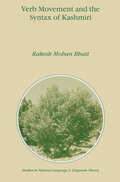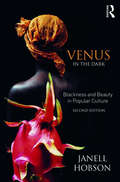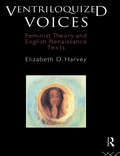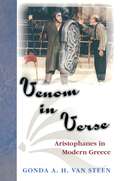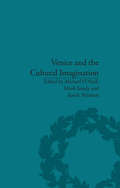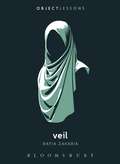- Table View
- List View
Verb Movement in Romance: A Comparative Study
by Norma SchifanoThis book provides a detailed account of verb movement across more than twenty standard and non-standard Romance varieties. Norma Schifano examines the position of the verb with respect to a wide selection of hierarchically-ordered adverbs, as laid out in Cinque's (1999) seminal work. She uses extensive empirical data to demonstrate that, contrary to traditional assumptions, it is possible to identify at least four distinct macro-typologies in the Romance languages: these macro-typologies stem from a compensatory mechanism between syntax and morphology in licensing the Tense, Aspect, and Mood interpretation of the verb. The volume adopts a hybrid cartographic/minimalist approach, in which cartography provides the empirical tools of investigation, and minimalist theory provides the technical motivations for the movement phenomena that are observed. It provides a valuable tool for the examination of fundamental morphosyntactic properties from a cross-Romance perspective, and constitutes a useful point of departure for further investigations into the nature and triggers of verb movement cross-linguistically.
Verb Movement and the Syntax of Kashmiri (Studies in Natural Language and Linguistic Theory #46)
by R.M. Bhatt3. 1 Kashmiri is not "non-Configurational" 45 3. 1 . 1 Agreement 51 3 . 1. 2 Binding Theory 52 3. 1. 3 Distribution of PRO 56 3 . 1. 4 Additional Evidence 57 3. 1. 4. 1 Weak Crossover (WCO) 57 3. 1. 4. 2 Constituent Fronting 60 3. 1. 4. 3 Superiority-Like Effects 62 3. 2 Word Order Constraints: Kashmiri Phrase Structure 64 3. 2. 1 N-complements 65 3. 2. 2 Postpositions 67 3. 2. 3 Adjectives 67 3. 2. 4 The Structure ofVP 68 3. 3. The Functional Projections 71 3. 4 Complement ki clauses 74 3. 5 Summary 79 4 Verb-Second (V2) Phenomena 80 4. 0 Introduction 80 4. 1 Kashmiri Vo rfe ld 84 4. 1. 1 V2 Clauses 85 4. 1. 1. 1 Main Clauses 85 4. 1. 1. 2 ki-Clauses 98 4. 1. 2 V3 Clauses 102 4. 1. 2. 1 Declarative Clauses 102 4. 1. 2. 2 Interrogative Clauses 107 4. 2 Some Exceptional Orders 116 vm 4. 2. 1 VI Order 116 4. 2. 1. 1 Declaratives 116 4. 2. 1. 2 Yes/No Questions 120 V-Final Order 4. 2. 2 121 4. 2. 2. 1 Relative Clauses and Adverbial Clauses 121 4. 2. 2. 2 Nonfinite Clauses 126 4. 3 Summary 129 5 Motivating Verb Movement 131 5. 0 Introduction 131 5. 1 The "Standard" Account 131 5. 2 Yiddish and Icelandic 136 5. 2. 1 Diesing (1990) 138 5. 2. 2 Weerman (1989) 141 5. 2. 3 Vikner (1991) 146 5.
Verb Movement and Expletive Subjects in the Germanic Languages (Oxford Studies in Comparative Syntax)
by Sten ViknerThis book is the study of two different kinds of variation across the Germanic languages. One involves the position of the finite verb, and the other the possible positions of the "logical" subject in constructions with expletive (or "dummy") subjects. The book applies the theory of Principles-and-Parameters to the study of comparative syntax. Several languages are considered, including less frequently discussed ones like Danish, Faroese, Icelandic, and Yiddish.
Verb Movement And Expletive Subjects In The Germanic Languages
by Sten ViknerThis book is the study of two different kinds of variation across the Germanic languages. One involves the position of the finite verb, and the other the possible positions of the "logical" subject in constructions with expletive (or "dummy") subjects. The book applies the theory of Principles-and-Parameters to the study of comparative syntax. Several languages are considered, including less frequently discussed ones like Danish, Faroese, Icelandic, and Yiddish.
Verb Movement and Clause Structure in Old Romanian (Oxford Studies in Diachronic and Historical Linguistics #18)
by Virginia Hill Gabriela AlboiuThe book provides a formal analysis of root and complement clauses in Old Romanian. Virginia Hill and Gabriela Alboiu examine the combination of Balkan syntactic patterns such as generalized subjunctive complementation on the one hand, and the Romance morphology that supplies complementizers and grammatical mood forms on the other. The consequences of this mixed typology range from root clauses with non-finite verbs to split heads and repeated recycling in clausal complements. The book argues that discourse triggers at the left periphery are responsible for fluctuations in verb movement in finite clauses, while with gerunds and imperatives verb movement follows from functional constraints. It further argues that clausal complements to control and raising verbs systematically display the pattern of the Balkan subjunctive, and that the spell out of these clausal complements has been repeatedly recycled during the development of Romanian. Verb Movement and Clause Structure in Old Romanian presents a new perspective on the manifestation of Balkan Sprachbund properties in the language, and on the nature of parametric differences in relation to other Romance languages. It provides a unified explanation for a range of constructions that have previously been treated as separate phenomena, and places diachronic changes in Romanian in a wider context.
Verantwortungszuschreibung im Journalismus: Responsibility Framing von Depressionen und Diabetes mellitus aus Kommunikator*innenperspektive
by Annemarie WiedickeDie Art und Weise, in der wir als Gesellschaft mit Gesundheit und Krankheit umgehen, wird maßgeblich durch Fragen der (Eigen-)Verantwortung geprägt: Wer ist verantwortlich dafür, dass ein Mensch erkrankt? Die Person selbst, ihr soziales Umfeld, oder strukturelle Gegebenheiten? Und wessen Aufgabe ist es, das entstandene Problem zu beheben? Wie oder wem Menschen gesundheitliche Verantwortung zuschreiben, wird nicht zuletzt durch das Framing in der journalistischen Berichterstattung beeinflusst. Einem interdisziplinären Ansatz folgend beleuchtet dieses Buch die Responsibility Frames in der Berichterstattung und ihren Entstehungsprozess – das Responsibility Frame Building. Am Beispiel von Depressionen und Diabetes mellitus werden mittels einer Kombination von Inhaltsanalyse und Leitfadeninterviews die mediale Darstellung von Verantwortung im Gesundheitskontext, die krankheitsspezifischen Vorstellungen von Journalist*innen sowie die individuellen, organisatorischen und externen Einflüsse auf die Berichterstattung beleuchtet. Die Befunde liefern einen wichtigen Einblick in Frame Building Prozesse in der journalistischen Nachrichtenproduktion. Dabei zeigt sich, dass Journalist*innen eine zentrale Rolle für die mediale Zuschreibung gesundheitlicher Verantwortung zukommt.
Veranstaltungskommunikation
by Christoph GronebergIn diesem Band wird aus medien- und kommunikationswissenschaftlichen, ingenieurwissenschaftlichen, philosophischen, geographischen oder rechtlichen Perspektiven, von Standpunkten des Veranstaltungs-, Verkehrs- und Social Media-Managements sowie aus feuerwehrlichen Überlegungen heraus Veranstaltungskommunikation thematisiert, denn: Kommunikation ist die Schnittstelle zwischenmenschlicher Interaktion. Ob im Alltag oder in krisenhaften oder katastrophischen Ausnahmesituationen ist sie eines der Mittel zur Herstellung von Sicherheit. Dies gilt auch und gerade im Kontext von Großveranstaltungen.
Vera Lex Historiae?: Constructions of Truth in Medieval Historical Narrative
In his Historia Ecclesiastica Gentis Anglorum (circa 731 CE), Bede says that he will write his account of the past of the English following only vera lex historiae (the true law of history). Whether explicitly or implicitly, historians narrate the past according to conceptions of what constitutes historical truth that emerge in the use of narrative strategies, formulae, and other textual forms, in establishing one’s ideological authority or that of one’s informants, and in faithfulness to a cultural, narrative, or poetic tradition. But what if we extend the scope of what we understand by history (especially in premodern settings) to include not just the writings of historians legitimated by the Latinate matrix of Christianized classical history writing, but also collective narratives, practices, rituals, oral poetry, liturgy, artistic representations, and acts of identity? In these genres of re-enacting the past as, or as representation of, the present, we find a plethora of modes of constructions of historical truth, narrative authority, and reliability. Vera Lex Historiae? comprises contributions that reveal the variety of evental strategies by which historical truth was constructed in late antiquity and the earlier Middle Ages, and the range of procedures by which such narratives were first established as being historical and then as “true” histories. This is not only a matter of narrative strategies, but also of habitus — ways of living and acting in the world that are deeply imbricated with the commemoration and re-enactment of the past by communities and by individuals. In doing this, Vera Lex Historiae? aims to recover something of the plurality of modes of preserving and reenacting the past available in late antiquity and the earlier middle ages which we often overlook because of preconceived notions of what constitutes history writing.
Venus in the Dark: Blackness and Beauty in Popular Culture
by Janell HobsonIn this second edition of the remarkable, and now classic, cultural history of black women’s beauty, Venus in the Dark, Janell Hobson explores the enduring figure of the "Hottentot Venus" and the history of critical and artistic responses to her by black women in contemporary photography, film, literature, music, and dance.In 1810, Sara Baartman was taken from South Africa to Europe, where she was put on display at circuses, salons, museums, and universities as the "Hottentot Venus." The subsequent legacy of representations of black women’s sexuality—from Josephine Baker to Serena Williams to hip-hop and dancehall videos—refer back to her iconic image. Via a new preface, Hobson argues for the continuing influence of Baartman’s legacy, as her image still reverberates through the contemporary marketization of black women’s bodies, from popular music and pornography to advertising. A brand new chapter explores how historical echoes from previous eras map onto highly visible bodies in the twenty-first century. It analyzes fetishistic spectacles of the black "booty," with particular emphasis on the role of Beyoncé Knowles in the popularization of the "bootylicious" body, and the counter-aesthetic the singer has gone on to advance for black women’s bodies and beauty politics.By studying the imagery of the "Hottentot Venus," from the nineteenth century to now, readers are invited to confront the racial and sexual objectification and embodied resistance that make up a significant part of black women’s experience.
Venus in the Dark: Blackness and Beauty in Popular Culture
by Janell HobsonIn this second edition of the remarkable, and now classic, cultural history of black women’s beauty, Venus in the Dark, Janell Hobson explores the enduring figure of the "Hottentot Venus" and the history of critical and artistic responses to her by black women in contemporary photography, film, literature, music, and dance.In 1810, Sara Baartman was taken from South Africa to Europe, where she was put on display at circuses, salons, museums, and universities as the "Hottentot Venus." The subsequent legacy of representations of black women’s sexuality—from Josephine Baker to Serena Williams to hip-hop and dancehall videos—refer back to her iconic image. Via a new preface, Hobson argues for the continuing influence of Baartman’s legacy, as her image still reverberates through the contemporary marketization of black women’s bodies, from popular music and pornography to advertising. A brand new chapter explores how historical echoes from previous eras map onto highly visible bodies in the twenty-first century. It analyzes fetishistic spectacles of the black "booty," with particular emphasis on the role of Beyoncé Knowles in the popularization of the "bootylicious" body, and the counter-aesthetic the singer has gone on to advance for black women’s bodies and beauty politics.By studying the imagery of the "Hottentot Venus," from the nineteenth century to now, readers are invited to confront the racial and sexual objectification and embodied resistance that make up a significant part of black women’s experience.
Venus
by Hanif KureishiWith VENUS, Hanif Kureishi turns his piercing gaze onto the pains of old age. Maurice (Peter O'Toole) and Ian (Leslie Phillips) are veteran stage actors whose slow, inevitable decline is disrupted by the arrival in their lives of Ian's niece Jessie (Jodie Whittaker). While Jessie's housekeeping skills make for a bone of contention with Ian, Maurice finds himself attracted to her. Kureishi has crafted a disturbing, wry and profoundly moving swansong for his characters. Also included in this volume is an Introduction by Kureishi in which he describes the inspiration he drew from the Japanese master Tanizaki.
Ventures into Childland: Victorians, Fairy Tales, and Femininity
by U. C. KnoepflmacherBehind the innocent face of Victorian fairy tales such as Through the Looking Glass or Mopsa the Fairy lurks the specter of an intense gender debate about the very nature of childhood. Offering brilliant rereadings of classics from the "Golden Age of Children's Literature" as well as literature commonly considered "grown-up," U. C. Knoepflmacher illuminates this debate, probing deeply into the relations between adults and children, adults and their own childhood selves, and the lives of beloved Victorian authors and their "children's tales." Ventures into Childland will delight and instruct all readers of children's classics, and will be essential reading for students of Victorian culture and gender studies. "Ventures into Childland is acute, well written and stimulating. It also has a political purpose, to insist on the importance of protecting and nurturing children, imaginatively and physically."—Jan Marsh, Times Literary Supplement "A provocative and interesting book about Victorian culture."—Library Journal
Ventriloquized Voices: Feminist Theory and English Renaissance Texts
by Elizabeth D. HarveyFirst published in 1992. Routledge is an imprint of Taylor & Francis, an informa company.
Ventriloquized Voices: Feminist Theory and English Renaissance Texts
by Elizabeth D. HarveyFirst published in 1992. Routledge is an imprint of Taylor & Francis, an informa company.
Venom in Verse: Aristophanes in Modern Greece
by Gonda A.H. Van SteenAristophanes has enjoyed a conspicuous revival in nineteenth- and twentieth-century Greece. Here, Gonda Van Steen provides the first critical analysis of the role of the classical Athenian playwright in modern Greek culture, explaining how the sociopolitical "venom" of Aristophanes' verses remains relevant and appealing to modern Greek audiences. Deriding or challenging well-known figures and conservative values, Aristophanes' comedies transgress authority and continue to speak to many social groups in Greece who have found in him a witty, pointed, and accessible champion from their "native" tradition. The book addresses the broader issues reflected in the poet's revival: political and linguistic nationalism, literary and cultural authenticity versus creativity, censorship, and social strife. Van Steen's discussion ranges from attitudes toward Aristophanes before and during Greece's War of Independence in the 1820s to those during the Cold War, from feminist debates to the significance of the popular music integrated into comic revival productions, from the havoc transvestite adaptations wreaked on gender roles to the political protest symbolized by Karolos Koun's directorial choices. Crossing boundaries of classical philology, critical theory, and performance studies, the book encourages us to reassess Aristophanes' comedies as both play-acts and modern methods of communication. Van Steen uses material never before accessible in English as she proves that Aristophanes remains Greece's immortal comic genius and political voice.
Venom in Verse: Aristophanes in Modern Greece (Princeton Modern Greek Studies #16)
by Gonda A.H. Van SteenAristophanes has enjoyed a conspicuous revival in nineteenth- and twentieth-century Greece. Here, Gonda Van Steen provides the first critical analysis of the role of the classical Athenian playwright in modern Greek culture, explaining how the sociopolitical "venom" of Aristophanes' verses remains relevant and appealing to modern Greek audiences. Deriding or challenging well-known figures and conservative values, Aristophanes' comedies transgress authority and continue to speak to many social groups in Greece who have found in him a witty, pointed, and accessible champion from their "native" tradition. The book addresses the broader issues reflected in the poet's revival: political and linguistic nationalism, literary and cultural authenticity versus creativity, censorship, and social strife. Van Steen's discussion ranges from attitudes toward Aristophanes before and during Greece's War of Independence in the 1820s to those during the Cold War, from feminist debates to the significance of the popular music integrated into comic revival productions, from the havoc transvestite adaptations wreaked on gender roles to the political protest symbolized by Karolos Koun's directorial choices. Crossing boundaries of classical philology, critical theory, and performance studies, the book encourages us to reassess Aristophanes' comedies as both play-acts and modern methods of communication. Van Steen uses material never before accessible in English as she proves that Aristophanes remains Greece's immortal comic genius and political voice.
Venom in Verse: Aristophanes in Modern Greece (Princeton Modern Greek Studies #16)
by Gonda A.H. Van SteenAristophanes has enjoyed a conspicuous revival in nineteenth- and twentieth-century Greece. Here, Gonda Van Steen provides the first critical analysis of the role of the classical Athenian playwright in modern Greek culture, explaining how the sociopolitical "venom" of Aristophanes' verses remains relevant and appealing to modern Greek audiences. Deriding or challenging well-known figures and conservative values, Aristophanes' comedies transgress authority and continue to speak to many social groups in Greece who have found in him a witty, pointed, and accessible champion from their "native" tradition. The book addresses the broader issues reflected in the poet's revival: political and linguistic nationalism, literary and cultural authenticity versus creativity, censorship, and social strife. Van Steen's discussion ranges from attitudes toward Aristophanes before and during Greece's War of Independence in the 1820s to those during the Cold War, from feminist debates to the significance of the popular music integrated into comic revival productions, from the havoc transvestite adaptations wreaked on gender roles to the political protest symbolized by Karolos Koun's directorial choices. Crossing boundaries of classical philology, critical theory, and performance studies, the book encourages us to reassess Aristophanes' comedies as both play-acts and modern methods of communication. Van Steen uses material never before accessible in English as she proves that Aristophanes remains Greece's immortal comic genius and political voice.
Venice Saved
by Simone WeilTowards the end of her life, the French philosopher and mystic Simone Weil (1909-43) was working on a tragedy, Venice Saved. Appearing here in English for the first time, this play explores the realisation of Weil's own thoughts on tragedy. A figure of affliction, a central theme in Weil's religious metaphysics, the central character offers a unique insight into Weil's broader philosophical interest in truth and justice, and provides a fresh perspective on the wider conception of tragedy itself.The play depicts the plot by a group of Spanish mercenaries to sack Venice in 1618 and how it fails when one conspirator, Jaffier, betrays them to the Venetian authorities, because he feels compassion for the city's beauty. The edition includes notes on the play by the translators as well as introductory material on: the life of Weil; the genesis and purport of the play; Weil and the tragic; the issues raised by translating Venice Saved. With additional suggestions for further reading, the volume opens up an area of interest and research: the literary Weil.
Venice Saved
by Simone WeilTowards the end of her life, the French philosopher and mystic Simone Weil (1909-43) was working on a tragedy, Venice Saved. Appearing here in English for the first time, this play explores the realisation of Weil's own thoughts on tragedy. A figure of affliction, a central theme in Weil's religious metaphysics, the central character offers a unique insight into Weil's broader philosophical interest in truth and justice, and provides a fresh perspective on the wider conception of tragedy itself.The play depicts the plot by a group of Spanish mercenaries to sack Venice in 1618 and how it fails when one conspirator, Jaffier, betrays them to the Venetian authorities, because he feels compassion for the city's beauty. The edition includes notes on the play by the translators as well as introductory material on: the life of Weil; the genesis and purport of the play; Weil and the tragic; the issues raised by translating Venice Saved. With additional suggestions for further reading, the volume opens up an area of interest and research: the literary Weil.
The Venice Myth: Culture, Literature, Politics, 1800 to the Present
by David BarnesVenice holds a unique place in literary and cultural history. Barnes looks at the themes of war, occupation, resistance and fascism to see how the political background has affected the literary works that have come out of this great city. He focuses on key British and American writers, including Byron, Ruskin, Pound and Eliot.
The Venice Myth: Culture, Literature, Politics, 1800 to the Present
by David BarnesVenice holds a unique place in literary and cultural history. Barnes looks at the themes of war, occupation, resistance and fascism to see how the political background has affected the literary works that have come out of this great city. He focuses on key British and American writers, including Byron, Ruskin, Pound and Eliot.
Venice and the Cultural Imagination: 'This Strange Dream upon the Water'
by Michael O'Neill Mark Sandy Sarah WoottonIn the era of the Grand Tour, Venice was the cultural jewel in the crown of Europe and the epitome of decadence. This edited collection of eleven essays draws on a range of disciplines and approaches to ask how Venice’s appeal has affected Western culture since 1800.
Venice and the Cultural Imagination: 'This Strange Dream upon the Water'
by Michael O’Neill Mark Sandy Sarah WoottonIn the era of the Grand Tour, Venice was the cultural jewel in the crown of Europe and the epitome of decadence. This edited collection of eleven essays draws on a range of disciplines and approaches to ask how Venice’s appeal has affected Western culture since 1800.
Veil and Vow: Marriage Matters in Contemporary African American Culture (Gender and American Culture)
by Aneeka Ayanna HendersonIn Veil and Vow, Aneeka Ayanna Henderson places familiar, often politicized questions about the crisis of African American marriage in conversation with a rich cultural archive that includes fiction by Terry McMillan and Sister Souljah, music by Anita Baker, and films such as The Best Man. Seeking to move beyond simple assessments of marriage as "good" or "bad" for African Americans, Henderson critically examines popular and influential late twentieth- and early twenty-first-century texts alongside legislation such as the 1996 Defense of Marriage Act and the Welfare Reform Act, which masked true sources of inequality with crisis-laden myths about African American family formation. Using an interdisciplinary approach to highlight the influence of law, politics, and culture on marriage representations and practices, Henderson reveals how their kinship veils and unveils the fiction in political policy as well as the complicated political stakes of fictional and cultural texts. Providing a new opportunity to grapple with old questions, including who can be a citizen, a "wife," and "marriageable," Veil and Vow makes clear just how deeply marriage still matters in African American culture.
Veil (Object Lessons)
by Rafia ZakariaObject Lessons is a series of short, beautifully designed books about the hidden lives of ordinary things. The veil can be an instrument of feminist empowerment, and veiled anonymity can confer power to women. Starting from her own marriage ceremony at which she first wore a full veil, Rafia Zakaria examines how veils do more than they get credit for. Part memoir and part philosophical investigation, Veil questions that what is seen is always good and free, and that what is veiled can only signal servility and subterfuge. From personal encounters with the veil in France (where it is banned) to Iran (where it is compulsory), Zakaria shows how the garment's reputation as a pre-modern relic is fraught and up for grabs. The veil is an object in constant transformation, whose myriad meanings challenge the absolute truths of patriarchy. Object Lessons is published in partnership with an essay series in The Atlantic.

